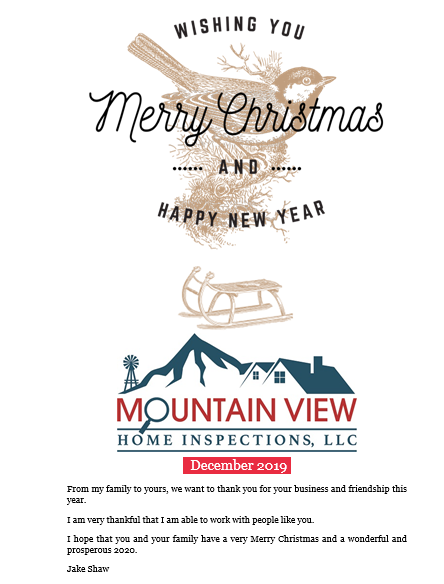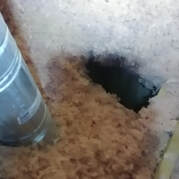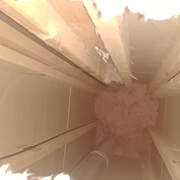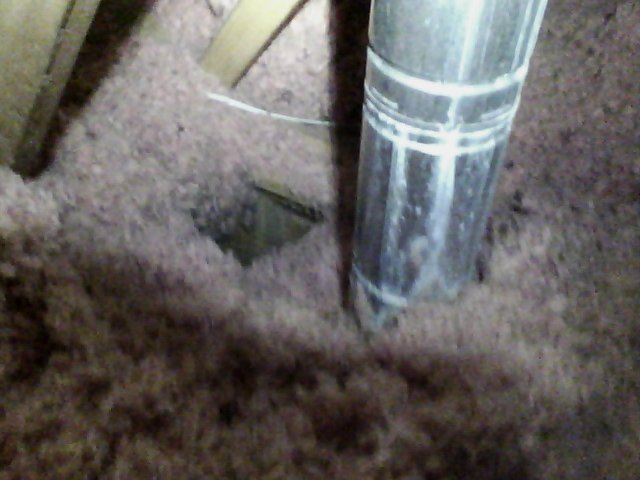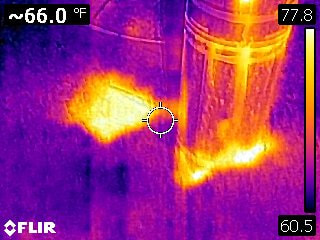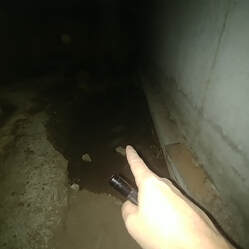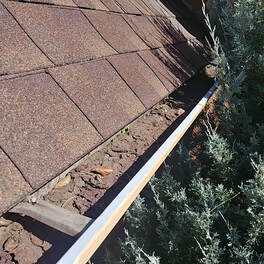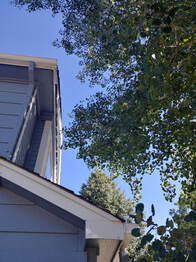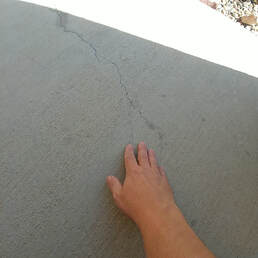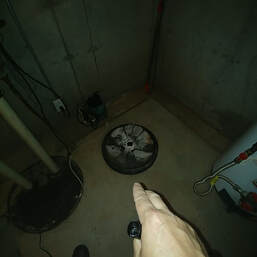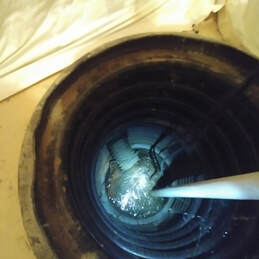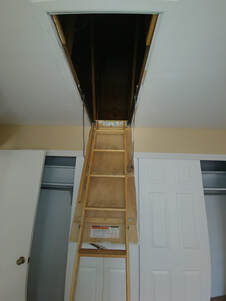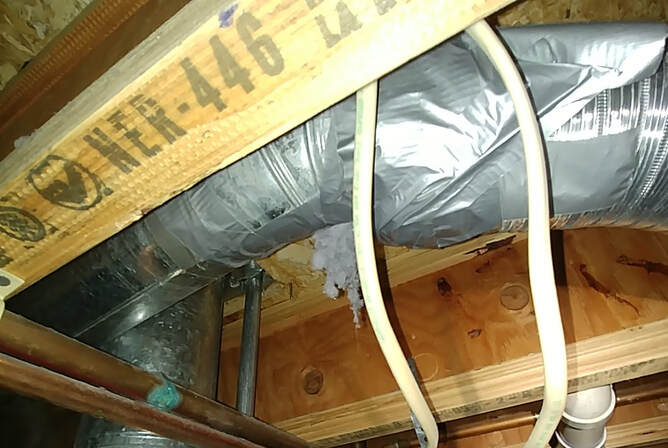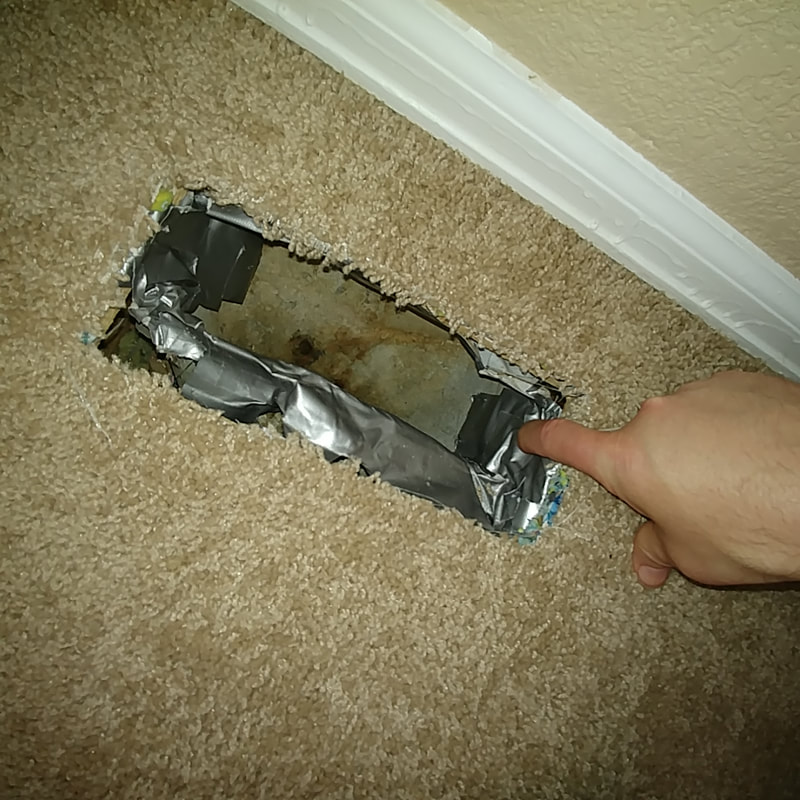|
At a recent home inspection in Palmer Lake Colorado, just outside of Colorado Springs, I was in the attic and noticed a hole near the furnace vent. There are several issues going on here. Safety, heat loss, and lack of effective attic insulation techniques.
Safety First - The first is that it is paramount that inspectors, home owners, ect. use caution when entering an attic. Always use a ladder tall enough that you enter the attic safely. Always know where you feet are and make sure you keep your feet on the truss stringer or bottom. Never step between the stringers. You will know if you are doing this correctly because your foot will not be through the ceiling of the room below you. (Watch National Lampoons Christmas Vacation for good example of what not to do.) Always keep three points of contact on the trusses around you and watch your head avoiding the nails protruding through the roof decking above you. Heat Loss - You can see in the third and forth picture that the heat is coming from the hole and furnace vent (hole left side and the furnace vent right side. The heat is from the homes conditioned air that the furnace is continually keeping at at comfortable temperature. What that orange spot represents is wasted money and resources. Furnace vents are naturally warmer than the surrounding area because they are venting the exhaust from the furnace combustion to outside the home. Not Effectively Insulated - When the home was brand new and was ready to be insulated, proper building techniques would be for the the hole to have been covered by drywall, backer board, plastic, ect. Then the insulation would be blown in as it was over the other areas. In this case the whole was missed and heat loss is the result. Whats the solution? - Luckily the solution is fairly easy. The hole just needs to be covered up and insulation be spread over the area. A few minutes worth will save the current and future home owners heating and cooling costs. Pro Tip - A 5 minute inspection of your attic once a year can help you save energy, identify roof leaks, and save you time, money, and frustration. My name is Jake Shaw "I am a home inspector and I help people. If you ever have any questions, please give me a call. 970-361-0477 MVHI4U.com When I am conducting a home inspection, one of the most common issues I find are down spouts that discharge water too close to the home. Gutters are designed to direct water collected from the roof and move it away from the home to keep its foundation and exterior dry. Literally hundreds of gallons of water can be collected at the roof and deposited right next to the foundation with too short of a downspout. In this scenario the soil surrounding the foundation and exterior of the home becomes saturated and migrates next to and under the foundation and left unchecked can cause significant foundation and moisture related issues.
Pro Tip - Ensuring that each down spout is 2 to 3 foot long and the landscaping slopes away from the home can save untold stress and financial loss. The leaves changing means that winter is on its way. One way to protect your home from the winter weather is to ensure your gutters are clean and that any limbs overhanging your roof are trimmed back. These help in a number of ways. Having clean gutters means that your gutters are less likely to become clogged which can lead to moisture intrusion and ice damning under the roof covering. Trimming the limbs keeps them clear of your home so that they do not rub on the siding during storms, ensures they will not drop leaves in your gutter, and limits the likelihood that they will break under a heavy snow load. Remember the May 2019 storm?
Pro-Tip - For a few hours of work on a sunny fall afternoon, you can save thousands of dollars in unexpected repairs. There are two type of concrete, that which has cracked and that which will. Cracks can come from the concrete drying process, improperly compacted soil under the concrete, or normal wear and tear. Water will naturally enter the crack and erode the concrete during the warm months but will actively push the concrete apart during its normal freeze and thaw cycles during the winter and spring. The important thing to remember is that the crack needs to be filled in order to keep moisture from entering the crack and causing further damage.
Pro-Tip - For less than $20 for concrete filler and a hour of work, most small cracks can be mitigated. With all the rain that we have had this summer it is time to check your sump pumps. I still come across sump pumps that are either not plugged in or are not working properly. Sump pumps are usually found in the lowest level of your home and are used to collect water from around your foundation and pump it away from your home protecting it from water intrusion.
To check if your sump pump is working: 1. Go to the lowest point in your home and look for a black circular object like the photo above. 2. Remove the lid. 3. Look inside with a flashlight. 4. Identify if you have a pump. 5. If you have a pump and there is standing water in the pit your pump may not be operating. 6. To check the pump operation add enough water to ensure the float is activating the float switch. 7. If the pump does not activate, call a licensed plumber for assistance. 8. If you don't have a pump, I recommend you call a licensed plumber for assistance. For more information see: www.nachi.org/sump-pumps.htm https://happydiyhome.com/sump-pump/ An attic pull-down ladder, also called an attic pull-down stairway or stairs, is a collapsible ladder that’s permanently attached to the attic floor. It’s used to access the attic without being required to use a portable ladder, which can be unstable, as well as inconvenient.
Common Defects It’s typical for the homeowner, rather than the professional builder, to install the attic pull-down stairs, especially if it’s an older home or a newer home that’s been built upward in order to use the attic for living or storage space. That’s why these stairs rarely meet safety standards and are prone to a number of defects. Some of the more common defective conditions include:
My name is Jake Shaw - "I am a home inspector and I help people." 970-361-0477 Duct tape has its uses but does not stand up so well over time. This dryer vent was so full of lint that it split the tape and the lint was blowing into the crawl space. The blockage was increasing the time and energy required to dry clothes and is also a fire hazard. My name is Jake Shaw - "I am a home inspector and I help people" 970-361-0477
When homes are placed on the market, they will likely be cleaned and freshly painted. When you are shopping for a home, take a look below the heating/cooling registers to see what the condition of the heating/cooling duct looks like. Often times they have dirt and debris in them and need to be cleaned. Other times they are not connected to floor system and need to be repaired. My name is Jake Shaw, "I am a home inspector and I help people". 970-361-0477
Your have closed on your home, moved in, now you can relax. It is not quite that easy but with a home maintenance plan you will have the road work laid out so that when maintenance or repairs need to be done you are prepared. The list below can serve has a handy guide. Please feel free to contact me and we can personalize your list. My name is Jake Shaw, "I am a home inspector and I help people." 970-361-0477
YOUR HOME MAINTENANCE TO-DO LIST Here are some key home maintenance projects that should be on your timeline: Within 1 Year of Purchase
Happy Small Business Week! If you own a small business in Colorado Springs, you are the backbone of the economy and your story needs to be heard. Email me your company name and website address and I will share it across my network. I hope you are having a great Colorado Day!
Crawlspaces are not the most fun thing to inspect but are arguably one of the most important. They can provide access to the homes foundation, plumbing, electrical, and HVAC systems which are not normally seen by the home owner everyday. By inspecting the crawlspace, Mountain View Home Inspections LLC can identify items of interest and provide a greater overall picture of the condition of the home. My name is Jake Shaw, "I am a home inspector and I help people."
The Bottom Line – Have your home tested for Radon.
If you are buying a home, own a home, or selling a home you should consider having it tested for Radon. This includes homes that currently have radon mitigation systems installed. Why? The majority of Colorado is identified as Zone 1. This means that the majority of Colorado counties including El Paso County, Teller County, Douglas County, and Pueblo County have a predicted average indoor radon screening levels greater than 4 pCi/L. No level of radon is safe however 4pCi/L is considered the actionable level by the EPA. According to the EPA "You can’t see, smell or taste radon, but it could be present at a dangerous level in your home. Radon is the leading cause of lung cancer deaths among nonsmokers in America and claims the lives of about 21,000 Americans each year. In fact, the EPA and the U.S. Surgeon General urge all Americans to protect their health by testing their homes, schools and other buildings for radon." "Exposure to radon is a preventable health risk and testing radon levels in your home can help prevent unnecessary exposure. If a high radon level is detected in your home, you can take steps to fix the problem to protect yourself and your family." Mountain View Home Inspections LLC is certified to test for Radon through the International Association of Certified Indoor Air Consultants and uses the cutting edge Sun Nuclear 1028 XP Continuous Radon Monitor. Call us for for testing: 970-361-0477 For more information about Radon click the button below. Bottom Line - Clean your clothes dryer lint filter every wash and vent pipe annually.
According to the US Fire Administration:
The Administration recommends the following: Clothes dryer do’s Installation
|
Mountain View Home Inspections LLC - "Every Home Deserves a Mountain View" - Certified Master Home Inspectors serving El Paso, Teller, Park, Douglas, Pueblo and Fremont Counties.
Telephone970-361-0477
|
ServicesHome Inspections, Radon Testing, Sewer Scope Inspections, Well Pump Testing
|

